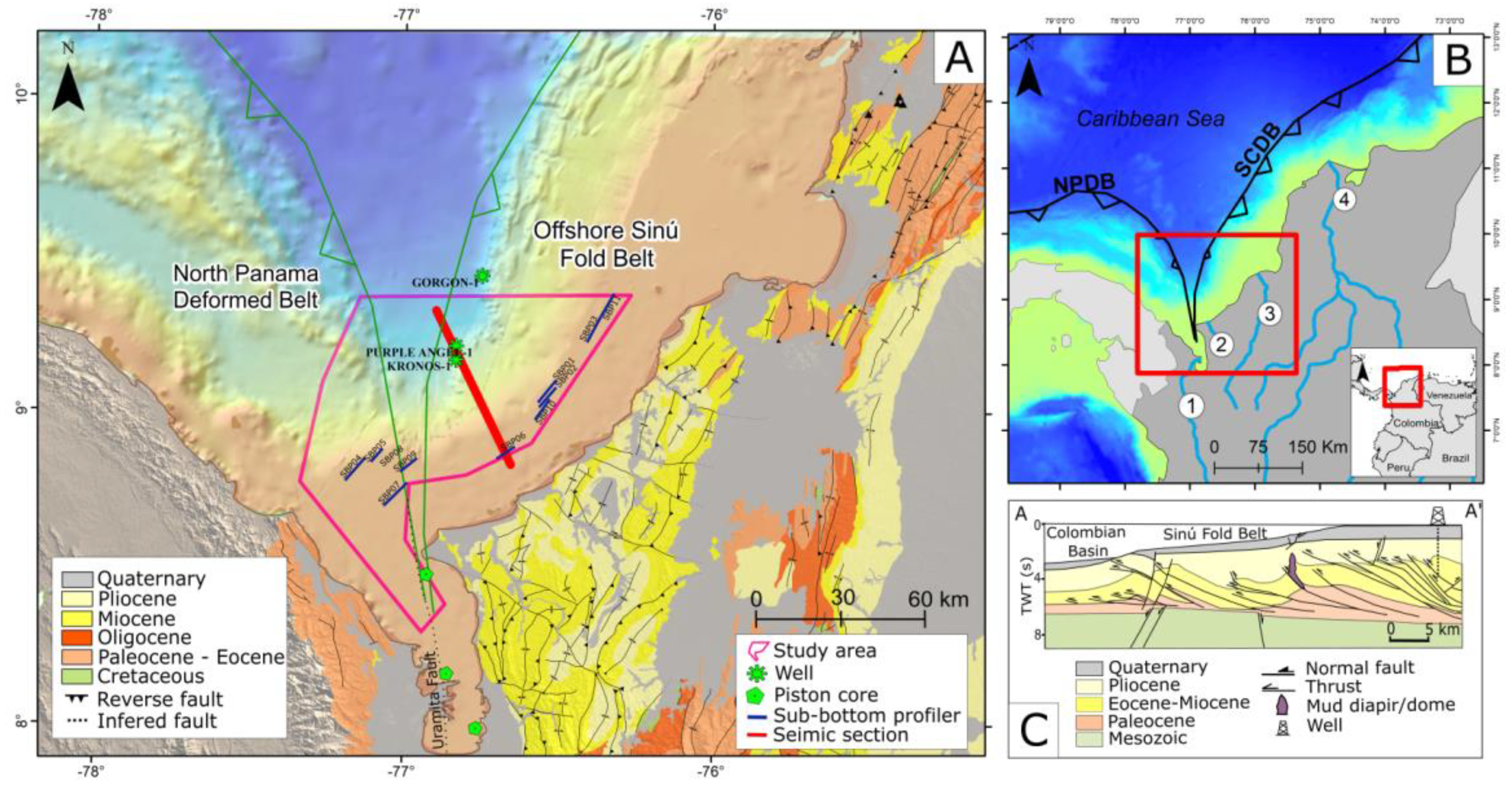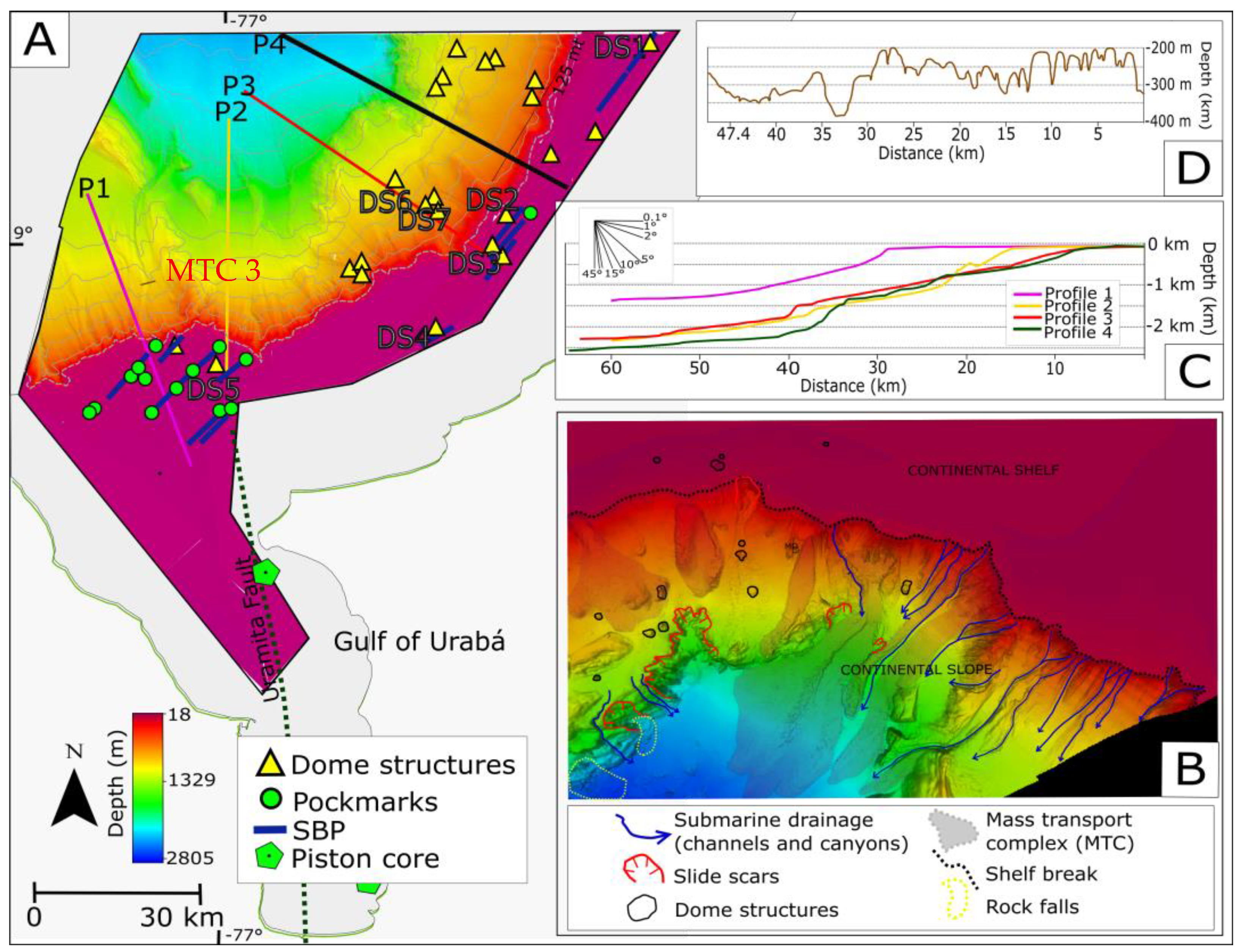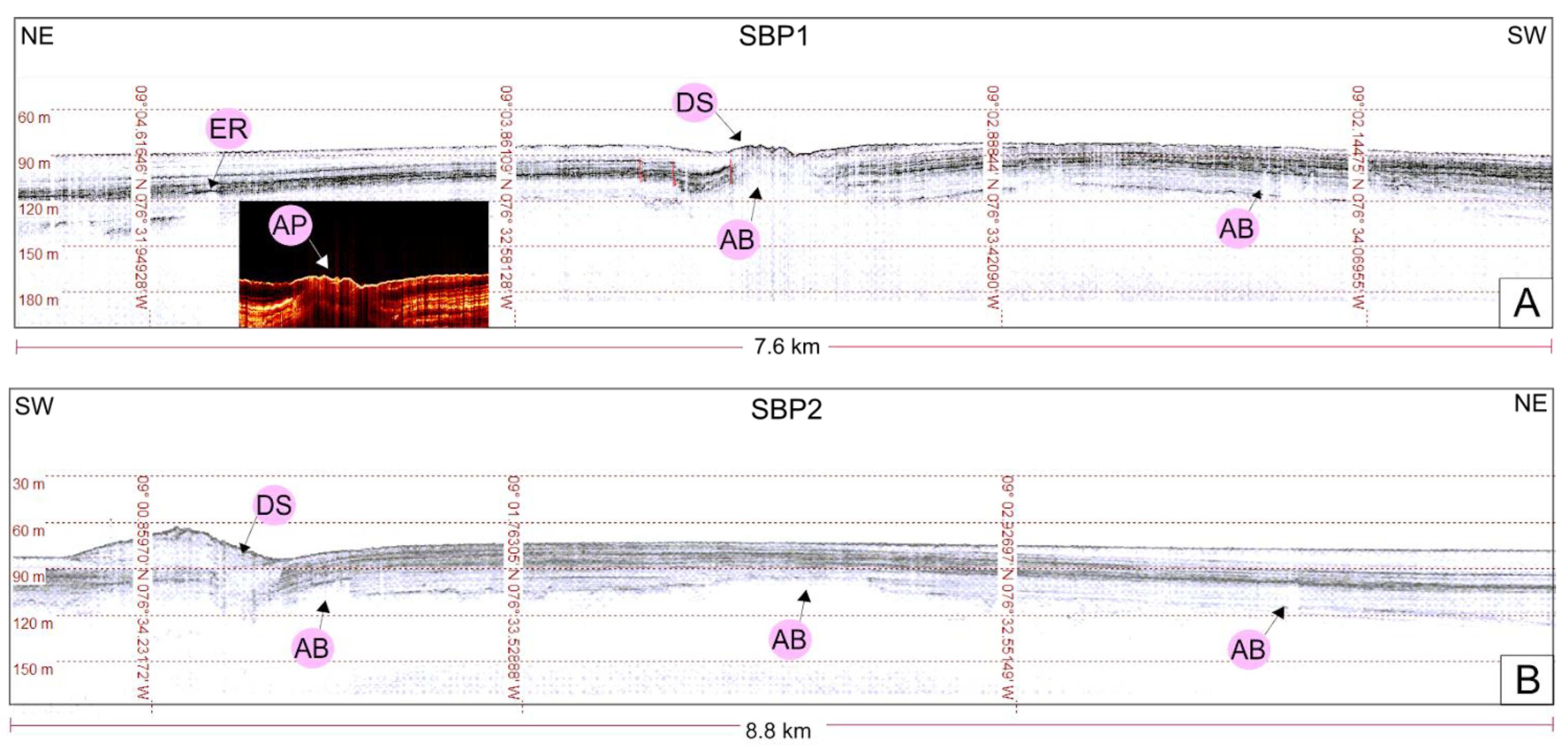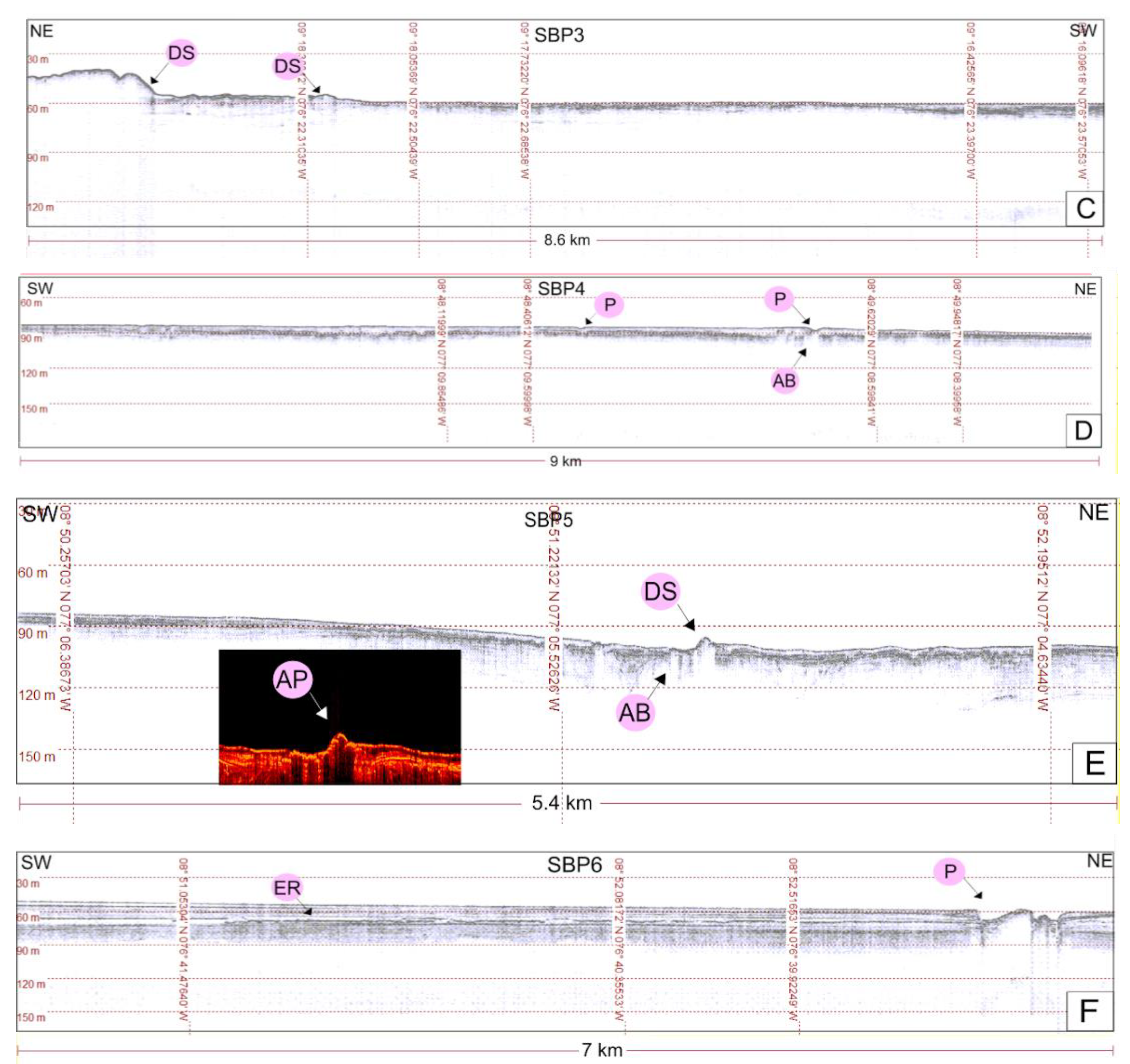Acoustic Evidence of Shallow Gas Occurrences in the Offshore Sinú Fold Belt, Colombian Caribbean Sea
Abstract
1. Introduction
2. Geological Configuration
3. Methods
4. Results
4.1. Seafloor Morphology
4.2. Dome Structures
4.3. Pockmarks
4.4. Sub-Seafloor Morphology
5. Discussion
6. Conclusions
Author Contributions
Funding
Institutional Review Board Statement
Informed Consent Statement
Data Availability Statement
Acknowledgments
Conflicts of Interest
References
- Hamilton, E.L. Geoacoustic modeling of the sea floor. J. Acoust. Soc. Am. 1980, 68, 1313–1340. [Google Scholar] [CrossRef]
- Gons, H.J.; Rijkeboer, M.; Bagheri, S.; Ruddick, K.G. Optical teledetection of chlorophyll a in estuarine and coastal waters. Environ. Sci. Technol. 2000, 34, 5189–5192. [Google Scholar] [CrossRef]
- Sun, K.; Cui, W.; Chen, C. Review of underwater sensing technologies and applications. Sensors 2021, 21, 7849. [Google Scholar] [CrossRef] [PubMed]
- Pszonka, J.; Schulz, B.; Sala, D. Application of mineral liberation analysis (MLA) for investigations of grain size distribution in submarine density flow deposits. Mar. Pet. Geol. 2021, 129, 105109. [Google Scholar] [CrossRef]
- Idárraga-García, J.; García-Varón, J.; León, H. Submarine geomorphology, tectonic features and mass wasting processes in the archipelago of San Andres, Providencia and Santa Catalina (Western Caribbean). Mar. Geol. 2021, 435, 106458. [Google Scholar] [CrossRef]
- Berrocoso, M.; Gárate, J.; Martín-Dávila, J.; Fernández-Ros, A.; Moreu, G.; Jigena, B. Improving the local geoid with GPS. Rep. Finn. Geod. Inst. 1996, 96, 91–96. [Google Scholar]
- Jigena, B.; Berrocoso, M.; Torrecillas, C.; Vidal, J.; Barbero, I.; Fernandez-Ros, A. Determination of an experimental geoid at Deception Island, South Shetland Islands, Antarctica. Antarct. Sci. 2016, 28, 277. [Google Scholar] [CrossRef]
- Payo, A.; Jigena Antelo, B.; Hurst, M.; Palaseanu-Lovejoy, M.; Williams, C.; Jenkins, G.; Lee, K.; Favis-Mortlock, D.; Barkwith, A.; Ellis, M.A. Development of an automatic delineation of cliff top and toe on very irregular planform coastlines (CliffMetrics v1. 0). Geosci. Model Dev. 2018, 11, 4317–4337. [Google Scholar] [CrossRef]
- Jigena, B.; Mamani, R.; Muñoz-Perez, J.J.; Garvi, D.; Walliser, J.; Calderay, F.; Berrocoso, M. Methodology for hydrological information management in waterways: Application to Bolivia. Tecnol. Cienc. Agua 2018, 9, 237–256. [Google Scholar] [CrossRef]
- Rey, W.; Ruiz-Salcines, P.; Salles, P.; Urbano-Latorre, C.P.; Escobar-Olaya, G.; Osorio, A.F.; Ramírez, J.P.; Cabarcas-Mier, A.; Jigena-Antelo, B.; Appendini, C.M. Hurricane Flood Hazard Assessment for the Archipelago of San Andres, Providencia and Santa Catalina, Colombia. Front. Mar. Sci. 2021, 8, 766258. [Google Scholar] [CrossRef]
- Osorio-Granada, A.M.; Antelo, B.J.; Pérez, J.M.V.; Hernández-Pardo, O.; Herman, L.; Muñoz-Pérez, J.J. Potential fields modeling for the Cayos Basin (Western Caribbean Plate): Implications in basin crustal structure. Mar. Geol. 2022, 449, 106819. [Google Scholar] [CrossRef]
- Jigena-Antelo, B.; Estrada-Ludeña, C.; Howden, S.; Rey, W.; Paz-Acosta, J.; Lopez-García, P.; Salazar-Rodriguez, E.; Endrina, N.; Muñoz-Pérez, J.J. Evidence of sea level rise at the Peruvian coast (1942–2019). Sci. Total Environ. 2023, 859, 160082. [Google Scholar] [CrossRef] [PubMed]
- Judd, A.G.; Hovland, M. The evidence of shallow gas in marine sediments. Cont. Shelf Res. 1992, 12, 1081–1095. [Google Scholar] [CrossRef]
- Van Weering, T.C.E.; Klaver, G.T.; Prins, R.A. Gas in Marine Sediments—An introduction. Mar. Geol. 1997, 137, 1–3. [Google Scholar] [CrossRef]
- Fleischer, P.; Orsi, T.; Richardson, M.; Anderson, A. Distribution of free gas in marine sediments: A global overview. Geo-Mar. Lett. 2001, 21, 103–122. [Google Scholar]
- Song, L.; Fan, D.; Su, J.; Guo, X. Controls on shallow gas distribution, migration, and associated geohazards in the Yangtze subaqueous delta and the Hangzhou Bay. Front. Mar. Sci. 2023, 10, 1107530. [Google Scholar] [CrossRef]
- Dimitrov, L.I. Mud volcanoes—A significant source of atmospheric methane. Geo-Mar. Lett. 2003, 23, 155–161. [Google Scholar] [CrossRef]
- Dondurur, D.; Çifçi, G.; Drahor, M.G.; Coşkun, S. Acoustic evidence of shallow gas accumulations and active pockmarks in the Izmir Gulf, Aegean Sea. Mar. Pet. Geol. 2011, 28, 1505–1516. [Google Scholar] [CrossRef]
- Roy, S.; Senger, K.; Hovland, M.; Römer, M.; Braathen, A. Geological controls on shallow gas distribution and seafloor seepage in an Arctic fjord of Spitsbergen, Norway. Mar. Pet. Geol. 2019, 107, 237–254. [Google Scholar] [CrossRef]
- Toker, M.; Tur, H. Shallow seismic characteristics and distribution of gas in lacustrine sediments at Lake Erçek, Eastern Anatolia, Turkey, from high-resolution seismic data. Environ. Earth Sci. 2021, 80, 1–23. [Google Scholar] [CrossRef]
- Carlson, P.R.; Golan-Bac, M.; Karl, H.A.; Kvenvolden, K.A. Seismic and geochemical evidence for shallow gas in sediment on Navarin continental margin, Bering Sea. Am. Assoc. Pet. Geol. Bull. 1985, 69, 422–436. [Google Scholar]
- Lee, S.H.; Chough, S.K. Distribution and origin of shallow gas in deep-sea sediments of the Ulleung Basin, East Sea (Sea of Japan). Geo-Mar. Lett. 2002, 22, 204–209. [Google Scholar] [CrossRef]
- Andreassen, K.; Nilssen, E.G.; Ødegaard, C.M. Analysis of shallow gas and fluid migration within the Plio-Pleistocene sedimentary succession of the SW Barents Sea continental margin using 3D seismic data. Geo-Mar. Lett. 2007, 27, 155–171. [Google Scholar] [CrossRef]
- Fader, G.B.J. Gas-related sedimentary features from the eastern Canadian continental shelf. Cont. Shelf Res. 1991, 11, 1123–1153. [Google Scholar] [CrossRef]
- Yuan, F.; Bennell, J.D.; Davis, A.M. Acoustic and physical characteristics of gassy sediments in the western Irish Sea. Cont. Shelf Res. 1992, 12, 1121–1134. [Google Scholar] [CrossRef]
- Ercilla, G. Gas-charged sediments and large pockmark-like features on the Gulf of Cadiz slope (SW Spain). Mar. Pet. Geol. 1996, 13, 253–261. [Google Scholar]
- Fader, G.B.J. The effects of shallow gas on seismic reflection profiles. In Glaciated Continental Margins: An Atlas of Acoustic Images; Springer: Berlin/Heidelberg, Germany, 1997; pp. 29–30. [Google Scholar]
- Missiaen, T.; Murphy, S.; Loncke, L.; Henriet, J.-P. Very high-resolution seismic mapping of shallow gas in the Belgian coastal zone. Cont. Shelf Res. 2002, 22, 2291–2301. [Google Scholar] [CrossRef]
- Schroot, B.M.; Klaver, G.T.; Schüttenhelm, R.T.E. Surface and subsurface expressions of gas seepage to the seabed—Examples from the Southern North Sea. Mar. Pet. Geol. 2005, 22, 499–515. [Google Scholar] [CrossRef]
- Gay, A.; Lopez, M.; Berndt, C.; Seranne, M. Geological controls on focused fluid flow associated with seafloor seeps in the Lower Congo Basin. Mar. Geol. 2007, 244, 68–92. [Google Scholar] [CrossRef]
- Hovland, M.; Curzi, P. V Gas seepage and assumed mud diapirism in the Italian central Adriatic Sea. Mar. Pet. Geol. 1989, 6, 161–169. [Google Scholar] [CrossRef]
- Fannin, N.G.T. Use of Regional Geological Surveys in the North Sea and Adjacent Areas in the Recognition of Offshore Hazards; Institute of Geological Sciences, Continental Shelf Division: London, UK, 1979. [Google Scholar]
- Lee, M.W.; Dillon, W.P. Amplitude blanking related to the pore-filling of gas hydrate in sediments. Mar. Geophys. Res. 2001, 22, 101–109. [Google Scholar] [CrossRef]
- Aiello, G.; Caccavale, M. New Seismoacoustic Data on Shallow Gas in Holocene Marine Shelf Sediments, Offshore from the Cilento Promontory (Southern Tyrrhenian Sea, Italy). J. Mar. Sci. Eng. 2022, 10, 1992. [Google Scholar] [CrossRef]
- Baltzer, A.; Tessier, B.; Nouze, H.; Bates, R.; Moore, C.; Menier, D. Seistec seismic profiles: A tool to differentiate gas signatures. Mar. Geophys. Res. 2005, 26, 235–245. [Google Scholar] [CrossRef]
- Hovland, M.; Judd, A. Seabed Pockmarks and Seepages: Impact on Geology, Biology, and the Marine Environment; Springer: Berlin/Heidelberg, Germany, 1988; ISBN 0860109488. [Google Scholar]
- Sheriff, R.E.; Geldart, L.P. Exploration Seismology; Cambridge University Press: Cambridge, UK, 1995; ISBN 1139643118. [Google Scholar]
- Davis, A.M. Shallow gas: An overview. Cont. Shelf Res. 1992, 12, 1077–1079. [Google Scholar] [CrossRef]
- King, L.H.; Maclean, B. Pockmarks on the Scotian shelf. Geol. Soc. Am. Bull. 1970, 81, 3141–3148. [Google Scholar] [CrossRef]
- Civile, D.; Baradello, L.; Accaino, F.; Zecchin, M.; Lodolo, E.; Ferrante, G.M.; Markezic, N.; Volpi, V.; Burca, M. Fluid-Related Features in the Offshore Sector of the Sciacca Geothermal Field (SW Sicily): The Role of the Lithospheric Sciacca Fault System. Geosciences 2023, 13, 231. [Google Scholar] [CrossRef]
- Kelley, J.T.; Dickson, S.M.; Belknap, D.F.; Barnhardt, W.A.; Henderson, M. Giant sea-bed pockmarks: Evidence for gas escape from Belfast Bay, Maine. Geology 1994, 22, 59–62. [Google Scholar] [CrossRef]
- Bøe, R.; Rise, L.; Ottesen, D. Elongate depressions on the southern slope of the Norwegian Trench (Skagerrak): Morphology and evolution. Mar. Geol. 1998, 146, 191–203. [Google Scholar] [CrossRef]
- Hatfield, L.E.; Tator, B.A.; Neff, C.H. Petroleum developments in South America, Central America, and Caribbean area in 1974. Am. Assoc. Pet. Geol. Bull. 1975, 59, 1756–1813. [Google Scholar]
- Amato, F.L. Petroleum Developments in South America, Central America, Mexico, and Caribbean Area in 1976. Am. Assoc. Pet. Geol. Bull. 1977, 61, 1578–1635. [Google Scholar]
- Katz, B.; Williams, K. Biogenic gas potential offshore Guajira peninsula, Colombia. In Proceedings of the AAPG Annual Meeting, Houston, TX, USA, 1–13 March 2002. [Google Scholar]
- Gonzalez-Penagos, F.; Milkov, A.; Lopez, E.; Duarte, L. Microbial and Thermogenic Petroleum Systems in the Colombian offshore Caribbean—New Geochemical Insights in an Emerging Basin. In Proceedings of the 2019 AAPG Annual Convention and Exhibition, San Antonio, TX, USA, 19–22 May 2019. [Google Scholar]
- Castaño, C. Golfos y Bahías de Colombia; Banco de Occidente: Cali, Colombia, 2002. [Google Scholar]
- Naranjo-Vesga, J.; Ortiz-Karpf, A.; Wood, L.; Jobe, Z.; Paniagua-Arroyave, J.F.; Shumaker, L.; Mateus-Tarazona, D.; Galindo, P. Regional controls in the distribution and morphometry of deep-water gravitational deposits along a convergent tectonic margin. Southern Caribbean of Colombia. Mar. Pet. Geol. 2020, 121, 104639. [Google Scholar] [CrossRef]
- Restrepo, J.D.; Kjerfve, B. The Pacific and Caribbean rivers of Colombia: Water discharge, sediment transport and dissolved loads. In Environmental Geochemistry in Tropical and Subtropical Environments; Springer: Berlin/Heidelberg, Germany, 2004; pp. 169–187. [Google Scholar]
- GEBCO, General Bathymetric Chart of the Oceans/GEBCO Web Services/Gridded Bathymetry Data/Download global coverage grids/Data Geotiff GEBCO_2023 Grid (Sub-Ice Topo/Bathy). Available online: https://www.gebco.net/data_and_products/gridded_bathymetry_data/#global (accessed on 14 September 2023).
- Gómez, J.; Montes, N.; Marín, E. Mapa Geológico de Colombia 2023. Escala 1:1 500 000; Servicio Geológico Colombiano: Bogotá, Colombia, 2023. [Google Scholar]
- Rodríguez, I.; Bulnes, M.; Poblet, J.; Masini, M.; Flinch, J. Structural style and evolution of the offshore portion of the Sinu Fold Belt (South Caribbean Deformed Belt) and adjacent part of the Colombian Basin. Mar. Pet. Geol. 2021, 125, 104862. [Google Scholar] [CrossRef]
- Naranjo-Vesga, J.; Paniagua-Arroyave, J.F.; Ortiz-Karpf, A.; Jobe, Z.; Wood, L.; Galindo, P.; Shumaker, L.; Mateus-Tarazona, D. Controls on submarine canyon morphology along a convergent tectonic margin. The Southern Caribbean of Colombia. Mar. Pet. Geol. 2022, 137, 105493. [Google Scholar] [CrossRef]
- Rodríguez, I.; Poblet, J.; Bulnes, M.; Masini, M.; Flinch, J. Thrust sequence in the Sinú Fold Belt (South Caribbean Deformed Belt), offshore northwestern Colombia. In Andean Structural Styles; Elsevier: Amsterdam, The Netherlands, 2022; pp. 111–119. [Google Scholar]
- Ladd, J.W.; Truchan, M. Compressional features across the Caribbean margin of Colombia. In Seismic Expression of Structural Styles: A Picture and Work Atlas; American Association of Petroleum Geologists: Tulsa, OK, USA, 1983. [Google Scholar]
- Toto, E.A.; Kellogg, J.N. Structure of the Sinu-San Jacinto fold belt—An active accretionary prism in northern Colombia. J. S. Am. Earth Sci. 1992, 5, 211–222. [Google Scholar] [CrossRef]
- Alfaro, E.; Holz, M. Review of the chronostratigraphic charts in the Sinú-San Jacinto Basin based on new seismic stratigraphic interpretations. J. S. Am. Earth Sci. 2014, 56, 139–169. [Google Scholar] [CrossRef]
- Duque-Caro, H. Estilo estructural, diapirismo y episodios de acrecimiento del terreno Sinú-San Jacinto en el noroccidente de Colombia. Bol. Geológico Ingeominas 1984, 27, 1–29. [Google Scholar] [CrossRef]
- Flinch, J.F. Structural evolution of the Sinu-Lower Magdalena area (northern Colombia). In The Circum-Gulf of Mexico and the Caribbean: Hydrocarbon Habitats, Basin Formation, and Plate Tectonics: AAPG Memoir 79; American Association of Petroleum Geologists: Tulsa, OK, USA, 2003. [Google Scholar]
- Mantilla, A.M. Crustal Structure of the Southwestern Colombian Caribbean Margin: Geological Interpretation of Geophysical Data. Ph.D. Thesis, Friedrich-Schiller-Universität, Jena, Germany, 2007. [Google Scholar]
- Mantilla, A.M.; Jentzsch, G.; Kley, J.; Alfonso-Pava, C.; Lallemand, S.; Funiciello, F. Configuration of the Colombian Caribbean Margin: Constraints from 2D seismic reflection data and potential fields interpretation. In Subduction Zone Geodynamics; Springer: Berlin/Heidelberg, Germany, 2009; pp. 247–272. [Google Scholar]
- Shepard, F.P.; Dill, R.F.; Heezen, B.C. Diapiric intrusions in foreset slope sediments off Magdalena delta, Colombia. Am. Assoc. Pet. Geol. Bull. 1968, 52, 2197–2207. [Google Scholar]
- Duque-Caro, H. Major Structural Elements and Evolution of Northwestern Colombia: Small Basin Margins. In M 29: Geological and Geophysical Investigations of Continental Margins; AAPG: Tulsa, OK, USA, 1979. [Google Scholar]
- Vernette, G.; Mauffret, A.; Bobier, C.; Briceno, L.; Gayet, J. Mud diapirism, fan sedimentation and strike-slip faulting, Caribbean Colombian Margin. Tectonophysics 1992, 202, 335–349. [Google Scholar] [CrossRef]
- Ruiz, C.; Davis, N.; Bentham, P.; Price, A.; Carvajal, D. Structure and tectonic evolution of the south Caribbean Basin, southern offshore Colombia: A progressive accretionary system. In Proceedings of the 7th Simposio Bolivariano—Exploracion Petrolera en las Cuencas Subandinas, Caracas, Venezuela, 10–13 September 2000. [Google Scholar]
- Aristizábal, C.; Ferrari, A.; Silva, C. Control neotectónico del diapirismo de lodo en la región de Cartagena, Colombia. Ing. Investig. y Desarro. I2+ D 2009, 8, 42–50. [Google Scholar]
- Vernette, G. La Plate-Forme Continentale Caraïbe de Colombie: Du Débouché du Magdalena au Golfe de Morrosquillo: Importance du Diapirisme Argileux sur la Morphologie et la Sédimentation; Institut de Géologie du Bassin d’Aquitaine: Talence, France, 1986. [Google Scholar]
- Vinnels, J.S.; Butler, R.W.H.; McCaffrey, W.D.; Paton, D.A. Depositional processes across the Sinú accretionary prism, offshore Colombia. Mar. Pet. Geol. 2010, 27, 794–809. [Google Scholar] [CrossRef]
- Zamora, G.; Mora, A. Andean Structural Styles: A Seismic Atlas; Elsevier: Amsterdam, The Netherlands, 2022; ISBN 0323859585. [Google Scholar]
- Rúa, A.; Liebezeit, G.; Molina, R.; Palacio, J. Unmixing progradational sediments in a southwestern Caribbean gulf through late Holocene: Backwash of low-level atmospheric jets. J. Coast. Res. 2016, 32, 397–407. [Google Scholar]
- Abegg, F.; Anderson, A.L. The acoustic turbid layer in muddy sediments of Eckernfoerde Bay, Western Baltic: Methane concentration, saturation and bubble characteristics. Mar. Geol. 1997, 137, 137–147. [Google Scholar] [CrossRef]
- Anderson, A.L.; Hampton, L.D. Acoustics of gas-bearing sediments I. Background. J. Acoust. Soc. Am. 1980, 67, 1865–1889. [Google Scholar] [CrossRef]
- Floodgate, G.D.; Judd, A.G. The origins of shallow gas. Cont. Shelf Res. 1992, 12, 1145–1156. [Google Scholar] [CrossRef]
- Ercilla, G.; Alonso, B.; Estrada, F.; Chiocci, F.L.; Baraza, J.; li Farran, M. The Magdalena Turbidite System (Caribbean Sea): Present-day morphology and architecture model. Mar. Geol. 2002, 185, 303–318. [Google Scholar] [CrossRef]
- Wood, W.T.; Ruppel, C. Seismic and thermal insvestigations of the Blake Ridge Gas Hydrate Area: A synthesis. Proc. Ocean Drill. program. Sci. results. Ocean Drill. Progr. 2000, 164, 253–264. [Google Scholar]
- Cukur, D.; Krastel, S.; Yama, T.; Namık, Ç. Seismic evidence of shallow gas from Lake Van, eastern Turkey. Mar. Pet. Geol. 2013, 48, 341–353. [Google Scholar] [CrossRef]
- Horozal, S.; Chae, S.; Kim, D.H.; Seo, J.M.; Lee, S.M.; Han, H.S.; Cukur, D.; Kong, G.-S. Seismic evidence of shallow gas in sediments on the southeastern continental shelf of Korea, East Sea (Japan Sea). Mar. Pet. Geol. 2021, 133, 105291. [Google Scholar] [CrossRef]
- Taylor, D.I. Nearshore shallow gas around the UK coast. Cont. Shelf Res. 1992, 12, 1135–1144. [Google Scholar] [CrossRef]
- Woodside, J.M.; Ivanov, M.K.; Limonov, A.F. Shallow gas and gas hydrates in the Anaximander Mountains region, eastern Mediterranean Sea. Geol. Soc. Lond. Spec. Publ. 1998, 137, 177–193. [Google Scholar] [CrossRef]
- Hustoft, S.; Bünz, S.; Mienert, J. Three-dimensional seismic analysis of the morphology and spatial distribution of chimneys beneath the Nyegga pockmark field, offshore mid-Norway. Basin Res. 2010, 22, 465–480. [Google Scholar] [CrossRef]
- Judd, A.; Hovland, M. Seabed Fluid Flow: The Impact on Geology, Biology and the Marine Environment; Cambridge University Press: Cambridge, UK, 2009; ISBN 1139461605. [Google Scholar]
- Neurauter, T.W.; Bryant, W.R. Seismic expression of sedimentary volcanism on the continental slope, northern Gulf of Mexico. Geo-Mar. Lett. 1990, 10, 225–231. [Google Scholar] [CrossRef]
- Graue, K. Mud volcanoes in deepwater Nigeria. Mar. Pet. Geol. 2000, 17, 959–974. [Google Scholar] [CrossRef]
- Somoza, L.; Gardner, J.M.; Díaz-del-Río, V.; Vázquez, J.T.; Pinheiro, L.M.; Hernández-Molina, F.J.; Parties, T.S.S. Numerous methane gas-related sea floor structures identified in Gulf of Cadiz. Eos Trans. Am. Geophys. Union 2002, 83, 541–549. [Google Scholar] [CrossRef]
- Gontharet, S.; Pierre, C.; Blanc-Valleron, M.-M.; Rouchy, J.-M.; Fouquet, Y.; Bayon, G.; Foucher, J.-P.; Woodside, J.; Mascle, J.; Party, T.N.S. Nature and origin of diagenetic carbonate crusts and concretions from mud volcanoes and pockmarks of the Nile deep-sea fan (eastern Mediterranean Sea). Deep Sea Res. Part II Top. Stud. Oceanogr. 2007, 54, 1292–1311. [Google Scholar] [CrossRef]
- Mazzini, A.; Svensen, H.H.; Planke, S.; Forsberg, C.F.; Tjelta, T.I. Pockmarks and methanogenic carbonates above the giant Troll gas field in the Norwegian North Sea. Mar. Geol. 2016, 373, 26–38. [Google Scholar] [CrossRef]
- CIOH Carta de Repartición de Facies Sedimentarias; Escala 1:300000; Centro de Investigaciones Oceanográficas e Hidrográficas: Cartagena, Colombia, 1999.
- Rangel-Buitrago, N.; Idárraga-García, J. Geología general, morfología submarina y facies sedimentarias en el margen continental y los fondos oceánicos del mar Caribe colombiano. In Biodiversidad de la Margen Continental del Caribe Colombiano; INVEMAR: Santa Marta, Columbia, 2010; pp. 29–51. [Google Scholar]
- Hovland, M.; Judd, A.G.; King, L.H. Characteristic features of pockmarks on the North Sea Floor and Scotian Shelf. Sedimentology 1984, 31, 471–480. [Google Scholar] [CrossRef]
- Camerlenghi, A.; Cita, M.B.; Della Vedova, B.; Fusi, N.; Mirabile, L.; Pellis, G. Geophysical evidence of mud diapirism on the Mediterranean Ridge accretionary complex. Mar. Geophys. Res. 1995, 17, 115–141. [Google Scholar] [CrossRef]
- Pérez-Belzuz, F.; Alonso, B.; Ercilla, G. History of mud diapirism and trigger mechanisms in the Western Alboran Sea. Tectonophysics 1997, 282, 399–422. [Google Scholar] [CrossRef]
- Gamberi, F.; Rovere, M. Mud diapirs, mud volcanoes and fluid flow in the rear of the Calabrian Arc Orogenic Wedge (southeastern Tyrrhenian sea). Basin Res. 2010, 22, 452–464. [Google Scholar] [CrossRef]
- Milkov, A.V. Worldwide distribution of submarine mud volcanoes and associated gas hydrates. Mar. Geol. 2000, 167, 29–42. [Google Scholar] [CrossRef]
- Sumner, R.H.; Westbrook, G.K. Mud diapirism in front of the Barbados accretionary wedge: The influence of fracture zones and North America–South America plate motions. Mar. Pet. Geol. 2001, 18, 591–613. [Google Scholar] [CrossRef]
- Kopf, A.J. Significance of mud volcanism. Rev. Geophys. 2002, 40, 2-1–2-52. [Google Scholar] [CrossRef]
- Krastel, S.; Spiess, V.; Ivanov, M.; Weinrebe, W.; Bohrmann, G.; Shashkin, P.; Heidersdorf, F. Acoustic investigations of mud volcanoes in the Sorokin Trough, Black Sea. Geo-Mar. Lett. 2003, 23, 230–238. [Google Scholar] [CrossRef]
- Sautkin, A.; Talukder, A.R.; Comas, M.C.; Soto, J.I.; Alekseev, A. Mud volcanoes in the Alboran Sea: Evidence from micropaleontological and geophysical data. Mar. Geol. 2003, 195, 237–261. [Google Scholar] [CrossRef]
- Somoza, L.; Dıaz-del-Rıo, V.; León, R.; Ivanov, M.; Fernández-Puga, M.C.; Gardner, J.M.; Hernández-Molina, F.J.; Pinheiro, L.M.; Rodero, J.; Lobato, A. Seabed morphology and hydrocarbon seepage in the Gulf of Cadiz mud volcano area: Acoustic imagery, multibeam and ultra-high resolution seismic data. Mar. Geol. 2003, 195, 153–176. [Google Scholar] [CrossRef]
- Morita, S.; Ashi, J.; Aoike, K.; Kuramoto, S. Evolution of Kumano basin and sources of clastic ejecta and pore fluid in Kumano mud volcanoes, Eastern Nankai Trough. In Proceedings of the International Symposium on Methane Hydrates and Fluid Flow in Upper Accretionary Prisms, Kyoto, Japan, 6 February–3 April 2004; Citeseer: University Park, PA, USA, 2004; pp. 92–99. Available online: https://acortar.link/OYJkj9 (accessed on 14 September 2023).
- León, R.; Somoza, L.; Medialdea, T.; González, F.J.; Díaz-del-Río, V.; Fernández-Puga, M.; Maestro, A.; Mata, M.P. Sea-floor features related to hydrocarbon seeps in deepwater carbonate-mud mounds of the Gulf of Cádiz: From mud flows to carbonate precipitates. Geo-Mar. Lett. 2007, 27, 237–247. [Google Scholar] [CrossRef]
- Paull, C.K.; Ussler, W., III; Borowski, W.S.; Spiess, F.N. Methane-rich plumes on the Carolina continental rise: Associations with gas hydrates. Geology 1995, 23, 89–92. [Google Scholar] [CrossRef]
- Hsu, S.-K.; Shiao-Shan, L.; Wang, S.-Y.; Ching-Hui, T.; Doo, W.-B.; Song-Chuen, C.; Jing-Yi, L.; Yeh, Y.-C.; Wang, H.-F.; Cheng-Wei, S. Seabed gas emissions and submarine landslides off SW Taiwan. TAO Terr. Atmos. Ocean. Sci. 2018, 29, 7. [Google Scholar] [CrossRef]
- Welte, D.H.; Tissot, P. Petroleum Formation and Occurrence; Springer: Berlin/Heidelberg, Germany, 1984; ISBN 0387132813. [Google Scholar]
- Ramirez, V.O. Stratigraphic Framework and Petroleum Systems Modeling, Guajira Basin Northern Colombia. Ph.D. Thesis, University of Alabama, Tuscaloosa, AL, USA, 2007. Available online: https://www.worldcat.org/es/title/stratigraphic-framework-and-petroleum-systems-modeling-guajira-basin-northern-colombia/oclc/191736499 (accessed on 14 September 2023).
- Mullins, H.T.; Nagel, D.K. Evidence for shallow hydrocarbons offshore northern Santa Cruz County, California. Am. Assoc. Pet. Geol. Bull. 1982, 66, 1130–1140. [Google Scholar]
- Gracia, A.; Rangel-Buitrago, N.; Sellanes, J. Methane seep molluscs from the Sinú–San Jacinto fold belt in the Caribbean Sea of Colombia. J. Mar. Biol. Assoc. 2012, 92, 1367–1377. [Google Scholar] [CrossRef]
- Von Cosel, R.; Olu, K. A new genus and new species of Vesicomyidae (Mollusca, Bivalvia) from cold seeps on the Barbados accretionary prism, with comments on other species. Zoosystema 2008, 30, 929–944. [Google Scholar]
- Von Cosel, R.; Olu, K. Large Vesicomyidae (Mollusca: Bivalvia) from cold seeps in the Gulf of Guinea off the coasts of Gabon, Congo and northern Angola. Deep Sea Res. Part II Top. Stud. Oceanogr. 2009, 56, 2350–2379. [Google Scholar] [CrossRef][Green Version]
- Saxena, R.C.; Seal, D.; Kumar, S.; Goyal, H.B. Thermo-chemical routes for hydrogen rich gas from biomass: A review. Renew. Sustain. Energy Rev. 2008, 12, 1909–1927. [Google Scholar] [CrossRef]
- Vedachalam, N.; Srinivasalu, S.; Rajendran, G.; Ramadass, G.A.; Atmanand, M.A. Review of unconventional hydrocarbon resources in major energy consuming countries and efforts in realizing natural gas hydrates as a future source of energy. J. Nat. Gas Sci. Eng. 2015, 26, 163–175. [Google Scholar] [CrossRef]








Disclaimer/Publisher’s Note: The statements, opinions and data contained in all publications are solely those of the individual author(s) and contributor(s) and not of MDPI and/or the editor(s). MDPI and/or the editor(s) disclaim responsibility for any injury to people or property resulting from any ideas, methods, instructions or products referred to in the content. |
© 2023 by the authors. Licensee MDPI, Basel, Switzerland. This article is an open access article distributed under the terms and conditions of the Creative Commons Attribution (CC BY) license (https://creativecommons.org/licenses/by/4.0/).
Share and Cite
Osorio-Granada, A.M.; Jigena-Antelo, B.; Vidal-Perez, J.; Zambianchi, E.; Osorio-Granada, E.G.; Torrecillas, C.; Romero-Cozar, J.; Leon-Rincón, H.; Oviedo-Prada, K.; Muñoz-Perez, J.J. Acoustic Evidence of Shallow Gas Occurrences in the Offshore Sinú Fold Belt, Colombian Caribbean Sea. J. Mar. Sci. Eng. 2023, 11, 2121. https://doi.org/10.3390/jmse11112121
Osorio-Granada AM, Jigena-Antelo B, Vidal-Perez J, Zambianchi E, Osorio-Granada EG, Torrecillas C, Romero-Cozar J, Leon-Rincón H, Oviedo-Prada K, Muñoz-Perez JJ. Acoustic Evidence of Shallow Gas Occurrences in the Offshore Sinú Fold Belt, Colombian Caribbean Sea. Journal of Marine Science and Engineering. 2023; 11(11):2121. https://doi.org/10.3390/jmse11112121
Chicago/Turabian StyleOsorio-Granada, Ana María, Bismarck Jigena-Antelo, Juan Vidal-Perez, Enrico Zambianchi, Edward G. Osorio-Granada, Cristina Torrecillas, Jeanette Romero-Cozar, Hermann Leon-Rincón, Karem Oviedo-Prada, and Juan J. Muñoz-Perez. 2023. "Acoustic Evidence of Shallow Gas Occurrences in the Offshore Sinú Fold Belt, Colombian Caribbean Sea" Journal of Marine Science and Engineering 11, no. 11: 2121. https://doi.org/10.3390/jmse11112121
APA StyleOsorio-Granada, A. M., Jigena-Antelo, B., Vidal-Perez, J., Zambianchi, E., Osorio-Granada, E. G., Torrecillas, C., Romero-Cozar, J., Leon-Rincón, H., Oviedo-Prada, K., & Muñoz-Perez, J. J. (2023). Acoustic Evidence of Shallow Gas Occurrences in the Offshore Sinú Fold Belt, Colombian Caribbean Sea. Journal of Marine Science and Engineering, 11(11), 2121. https://doi.org/10.3390/jmse11112121











